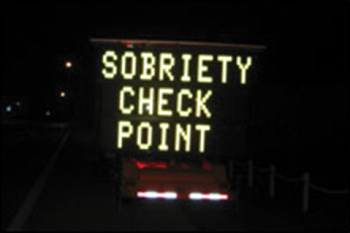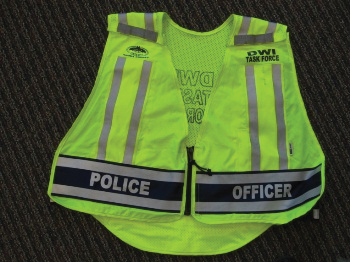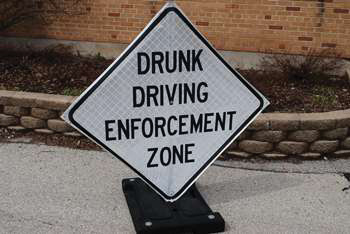|
||||||||||||
The following article is an example of the strategies utilized by traffic enforcement agencies in their goal to provide traffic safety. It is being provided to shed some understanding for the enforcement initiatives and practices all vehicle operators are exposed to throughout the United States. It is designed for traffic enforcement organizations. — Editor
DRIVING SAFETY: ENFORCEMENT AND JUSTICE SERVICES
HVE Enforcement High Visibility Enforcement combines enforcement, visibility elements, and a publicity strategy to educate the public and promote voluntary compliance with the law. Checkpoints, saturation patrols and other HVE strategies should include increased publicity and warnings to the public. Although forewarning the public might seem counterproductive to apprehending violators, it actually increases the deterrent effect. The HVE concept is a departure from traditional law enforcement tactics. HVE incorporates enforcement strategies, such as enhanced patrols using visibility elements (e.g. electronic message boards, road signs, command posts, BAT mobiles, etc.) designed to make enforcement efforts obvious to the public. It is supported by a coordinated communication strategy and publicity. HVE may also be enhanced through multi-jurisdictional efforts and partnerships between people and organizations dedicated to the safety of their community.
Saturation Patrol Increased squads conduct enforcement in a targeted area to gain voluntary compliance of traffic laws and create general deterrence to prevent traffic violations. Note: increased enforcement must be visible to the motoring public. They need to see officers making traffic stops. Stopping vehicles, or a specific sequence of vehicles (e.g., every fifth vehicle), at a predetermined fixed location detect drivers who are impaired by alcohol or other drugs. One purpose of a sobriety checkpoint is to increase the perceived risk of detection and arrest for individuals who might otherwise decide to engage in unsafe driving behavior. This is a checkpoint’s general deterrence effect. The fact that all, or a proportion of, vehicles are stopped reduces the impaired driver’s confidence that they can avoid detection by concealing or compensating for alcohol or drug impairment. The following documents provide guidance on these enforcement strategies:
available online at: www.nhtsa.gov/people/injury/alcohol/saturation_patrols/SatPats2002.pdf
available online at: www.nhtsa.gov/people/injury/enforce/LowStaffing_Checkpoints/images/LowStaffing.pdf
Increased enforcement of a specific traffic violation in a targeted location for a short period of time that occurs periodically. Example 1. Speed enforcement waves can be conducted several times a month for a few hours, immediately after rush hour when motorists are attempting to make up lost time due to traffic congestion. Example 2. DWI Waves may be conducted two weekends in one month from 10 pm - 2 am or target a special event that is occurring (e.g., festival, sporting event, St. Patrick's Day).
High visibility enforcement strategies and elements incorporated into your everyday enforcement. Integrating high visibility traffic enforcement as a standard practice lets the public know that traffic enforcement is an agency priority. It also assists in reducing other crimes while at the same
Multi-jurisdictional efforts combine your resources and your efforts with neighboring jurisdictions including “non-traditional” agencies (e.g., park police, campus police, ABC officers, game wardens, etc.) The multi-jurisdictional approach is a critical countermeasure in traffic safety. When you have more participating agencies you create a greater police presence which in turn creates general deterrence because it increases the risk (or perceived risk) that the motoring public will be caught. The enforcement must be highly visible and include an equal balance of enforcement and publicity. Some benefits of multi-jurisdictional efforts:
High visibility enforcement should be conducted in locations that are chosen based on data. Enforcement should be in areas that are easily visible to the motoring public and indicate a specific enforcement need due to crashes or crashes and crime. Using geomapping to identify “hot spots”, areas of high incidence of crimes and crashes, will help you target locations where your enforcement can play two roles in fighting crime and reducing crashes and traffic violations. Choosing a location that is a high volume traffic area will assist with the visibility of your enforcement efforts. People will see you out there enforcing the traffic laws. This helps create general deterrence and voluntary compliance of laws.
The HVE concept is a departure from traditional law enforcement tactics. HVE incorporates enforcement strategies such as enhanced patrols using visibility elements (e.g. electronic message boards, road signs, command posts, BAT mobiles, etc.) designed to make enforcement efforts obvious to the public. The goal of HVE is to make the motoring public aware of your enforcement efforts and create deterrence. When the perceived risk of getting caught by law enforcement goes up, the likelihood that people will engage in unsafe driving behaviors goes down. Choose some or all of these visibility elements to enhance your enforcement:
TRAINING Prior to conducting your HVE program, ensure that all officers who will be deployed are current on their training and certifications. Conduct refresher training as required. Courses that should be delivered to all officers participating in your HVE may include the following
Measuring effectiveness will be different for each individual agency and type of enforcement. If you are working with a funding source such as your State Highway Safety Office, they will have specific information they want you to report. Check your funding requirements for guidance. Collecting data will highlight goals that are being accomplished, identify gaps, and help you evaluate the overall effectiveness of your program. Remember: HVE is designed to change unlawful traffic behaviors and reduce crashes, injuries and fatalities. It is not a strategy designed to increase arrests; in fact, it may yield decreased citation counts over time
When planning your HVE program, it is important to include evaluation early in your planning so that you can collect data before your event. This data will then be used to measure the amount of change in the behaviors of the motoring public after your HVE has concluded.
The qualitative evaluation is a look at the success of meeting your HVE program activities—did you do what you planned to do. It looks at activities conducted that may have resulted in a change of behavior. Questions answered in a process evaluation may include:
Quantitative evaluations look at numbers, data, and statistics to measure the impact of the program. Some common measures include:
Surveys can be particularly useful in measuring the effectiveness of media and publicity. Surveys can be conducted in many ways: focus groups, interviews, mail or email questionnaires, Internet survey instruments such as Survey Monkey, etc. Questions that may be asked to determine the effectiveness of your media and publicity campaign include:
Based on analyses of data from previous deployments, you will be able to:
© 2013 TLC Magazine Online, Inc. |
||||||||||||






